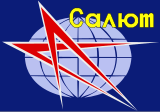Salyut 3
 |
|
| Station statistics | |
|---|---|
| COSPAR ID | 1974-046A |
| Call sign | Salyut 3 |
| Crew | 2 |
| Launch | 25 June 1974 04:15:00 UTC |
| Launch pad | LC-81/23, Baikonur Cosmodrome, Soviet Union |
| Reentry | 24 January 1975 |
| Mass | 18,900 kg (at launch) |
| Length | 14.55 m |
| Width | 4.15 m (maximum diameter) |
| Pressurised volume | 90 m³ |
| Perigee | 219 kilometres (136 mi) (initial orbit) |
| Apogee | 270 kilometres (170 mi) (initial orbit) |
| Orbital inclination | 51.6 degrees |
| Orbital period | 89.1 minutes |
| Days in orbit | 213 days |
| Days occupied | 15 days |
| Statistics as of de-orbit and reentry | |
| Configuration | |

Salyut 3 diagram
|
|
Salyut 3 (Russian: Салют-3; English: Salute 3; also known as OPS-2 or Almaz 2) was a Soviet space station launched on 25 June 1974. It was the second Almaz military space station, and the first such station to be launched successfully. It was included in the Salyut program to disguise its true military nature. Due to the military nature of the station, the Soviet Union was reluctant to release information about its design, and about the missions relating to the station.
It attained an altitude of 219 to 270 km on launch and NASA reported its final orbital altitude was 268 to 272 km. Only one of the three intended crews successfully boarded and manned the station, brought by Soyuz 14; Soyuz 15 attempted to bring a second crew but failed to dock.
Although little official information has been released about the station, several sources report that it contained multiple Earth-observation cameras, as well as an on-board gun. The station was deorbited, and re-entered the atmosphere on 24 January 1975. The next space station launched by the Soviet Union was the civilian station Salyut 4; the next military station was Salyut 5, which was the final Almaz space station.
The first space station, Salyut 1 (also called DOS-1) had been launched by the Soviet Union in April 1971. Only one mission successfully docked with Salyut 1, which was Soyuz 11, whose three-person crew stayed aboard the station for 22 days in June 1971. After undocking from the station, the Soyuz 11 crew were killed just before reentry.
At the time there were competing "civilian" and pure military Soviet space programs; Salyut 1, for example, was developed as a "civilian" program. Other civilian stations, called Long-term Orbital Stations (DOS), were considered successors of Salyut 1. These consisted of the unsuccessful DOS-2 in 1972, DOS-3 in 1974, and later the successful Salyut 4, Salyut 6, and Salyut 7.
...
Wikipedia
